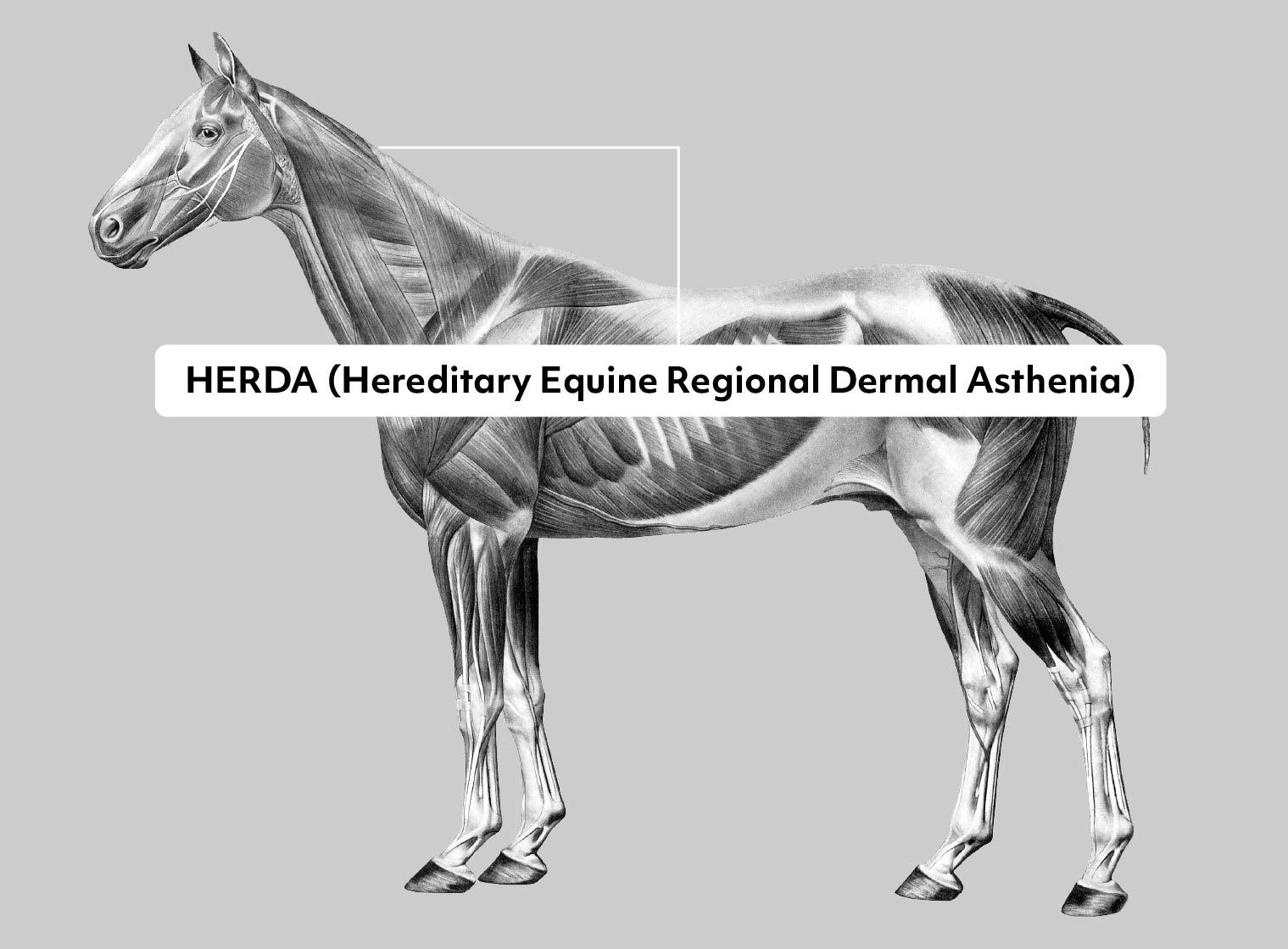Hereditary Equine Regional Dermal Asthenia (HERDA)
Gene or Region: PPIB
Reference Variant: G
Mutant Variant: A
Affected Breeds: Quarter Horse
Research Confidence: High - Findings reproduced in multiple studies
Explanation of Results: herda/herda = homozygous for Hereditary Equine Regional Dermal Asthenia, trait expressed, may result in severe/fatal health issues herda/n = heterozygous for Hereditary Equine Regional Dermal Asthenia, carrier n/n = no variant detected
General Description for Hereditary Equine Regional Dermal Asthenia (HERDA)
Hereditary Equine Regional Dermal Asthenia (HERDA) is a degenerative skin disease that primarily affects the American Quarter Horse breed. Loose skin is often an early indication of the disease, and severe seromas, hematomas, ulcerations usually develop around 1.5 years of age and progressively worsen. There is no cure, and the majority of affected animals have to be euthanized within 2-4 years.
A missense mutation in the equine cyclophilin B (PPIB) was determined to cause a functional defect in this protein, resulting in less effective catalysis of the rate-limiting step in collagen folding. Etalon offers diagnostic testing to determine carrier or affected status.
This disease follows an autosomal recessive mode of inheritance, so in order for the foal to be affected, both the sire and the dam must carry the allele. This also means that horses can appear normal but be carriers for the condition. If two carrier horses mate, there is a 25% chance that the foal will have HERDA. Studies estimate that ~3.5% of Quarter Horses are carriers. It's recommended that both carriers and clinically affected horses with HERDA be removed from breeding programs.
References
Tryon et al., “Homozygosity mapping approach identifies a missense mutation in equine cyclophilin B (PPIB) associated with HERDA in the American Quarter Horse.” (2007) Genomics 90: 93-102. PMID: 17498917
Ishikawa Y, Vranka JA, Boudko SP, Pokidysheva E, Mizuno K, Zientek K, Keene DR, Rashmir-Raven AM, Nagata K, Winand NJ, Bächinger HP. Mutation in cyclophilin B that causes hyperelastosis cutis in American Quarter Horse does not affect peptidylprolyl cis-trans isomerase activity but shows altered cyclophilin B-protein interactions and affects collagen folding. J Biol Chem. 2012 Jun 22;287(26):22253-65. doi: 10.1074/jbc.M111.333336. Epub 2012 May 3. PMID: 22556420; PMCID: PMC3381186.
More Horse Health
Junctional Epidermolysis Bullosa 1
Junctional Epidermolysis Bullosa (JEB), also known as red foot disease or hairless foal syndrome, results in the inability to produce the proteins needed to keep the skin on the body. Affected foals exhibit symptoms within days of birth, including blisters at the pressure points, detatchment of the hooves, and oral ulcers. As there is no treatment, affected foals are humanely euthanized.
Kissing Spines Susceptibility Risk
Kissing Spines Susceptibility (KSS) evaluates a horses genetic risk for developing Kissing Spines. Horses diagnosed with Kissing Spines will have two or more dorsal spinous processes that are too close together, touch, or even overlap. This bone-on-bone grinding causes varying degrees of pain, and thus decreased mobility.
Lavender Foal Syndrome
Lavender foal syndrome (LFS), also known as coat color dilution lethal, is a neurological dysfunction in newborn foals. Symptoms are apparent at birth and include seizures, severe hyper-extension of limbs, neck and back, stiff paddling leg movements, involuntary eye movement and inability to stand or sit upright. The coat usually has a dilute color that ranges in shade from silver to a pale lavender/pink. As there is no treatment, affected foals are humanely euthanized.
